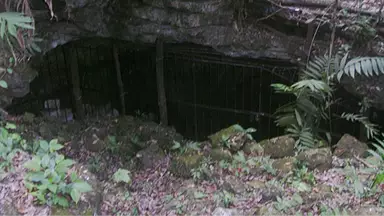New research has given more detail about what the aptly named ‘Blood Cave’ was used for thousands of years ago.
Cueva de Sangre, or the ‘Blood Cave’, has proved fascinating for researchers for decades.
The cave, a Maya ruin, is located beneath the archaeological site of Dos Pilas in Petén, Guatemala, and is one of more than a dozen caves in this region that were used by the Maya people – the Indigenous people of Mesoamerica, specifically southern Mexico and northern Central America.
Archeologists have concluded that the caves were likely used by the people between 400 BC and AD 250, and human bones that were previously discovered in the underground cave have given researchers a greater look into the Maya culture.
The discovery of the bones isn’t anything new, however, as they were found in the early 1990s. But the most interesting thing about the hundreds of bones that were discovered was the condition they were found in.


Many of the bones found in the Blood Cave had evidence of traumatic injuries (Michele Bleuze)
Many have shown that they actually bore evidence of traumatic injuries around the time of their death.
New analysis has concluded that the remains were likely from people who were dismembered as part a ritual sacrifice an estimated 2,000 years ago – giving the Blood Cave’s name a chilling meaning.
The artifacts that were discovered in the caves, which included obsidian blades, also help promote the idea that sacrifices took place here.
Experts have also highlighted the clues that indicate the individuals didn’t just seemingly die of these injuries and were buried there.
Michele Bleuze, a bioarchaeologist at California State University, Los Angeles, spoke to Live Science and said: “The emerging pattern that we’re seeing is that there are body parts and not bodies.
“In Maya ritual, body parts are just as valuable as the whole body.”


Cave entrance near El Duende (Noche de la pena/Wikimedia Commons)
Ellen Fricano, a forensic anthropologist at Western University of Health Sciences, examined the bones that were found and told Live Science: “There are a few lines of evidence that we used to determine that this was more likely a ritual site than not.”
She highlighted that bones were on the surface, rather than buried, and the injuries to the bones suggest ritual dismemberment, rather than immediate burial.
As well as this, a fragment of the left side of the forehead had a mark suggesting that someone used a tool like a hatchet on the skull and this was made around the time of death.
Bleuze concluded that more research needed to be done to have a better understanding of the ritual and uncover the mystery stating that the analysis of the bones had only just begun.
Featured Image Credit: Noche de la pena/Wikimedia Commons
Topics: News, Science, World News, History
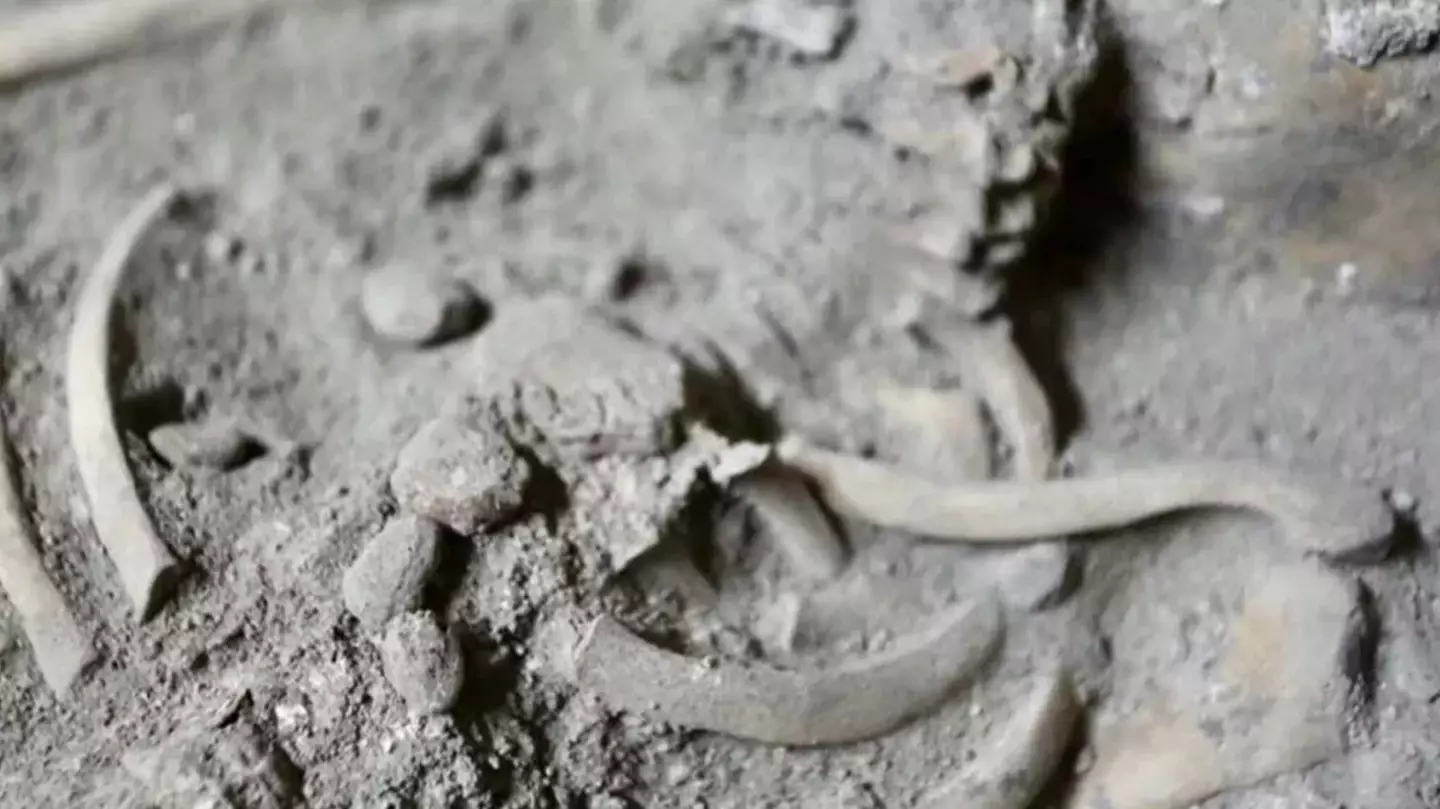

An ancient skeleton found in a remote cave could ‘rewrite human history’, experts have claimed.
Archeologists have made a groundbreaking discovery, having unearthed the remains of a child from the Stone Age in a remote cave in Thailand.
The bones, estimated to be around 29,000 years old, are the oldest human remains to have ever been found in the Southeast Asian country and challenge previous beliefs of when our early ancestors roamed the region from the late Pleistocene era, as per Livescience.
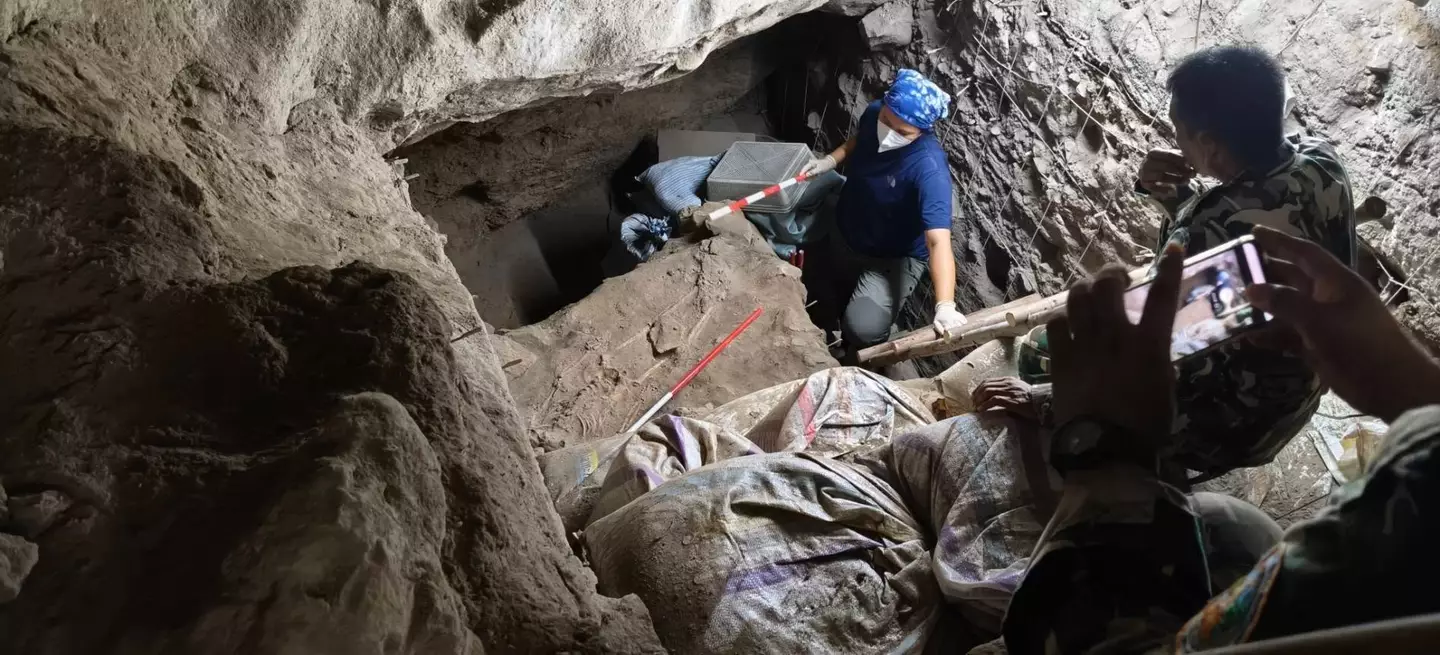

The excavation site (นสพ.ประจวบโพสต์/Prachuap Post/Facebook)
The historic skeletal remains of the child, believed to be around six or eight-years-old at the time of death, has since been nicknamed ‘Pangpond’ in reference to a beloved Thai cartoon character.
The youngster’s remains were also interestingly found in an apparent ‘ritualistic’ burial site within Tham Din Cave, some 125 meters above sea level, in Khao Sam Roi Yot National Park.
The site is already renowned for its prehistoric rock art, but now it stands as another unique reference point for early human activity in the country.


The skeleton challenges previous beliefs about prehistoric activity in the country (นสพ.ประจวบโพสต์/Prachuap Post/Facebook)
The Thai government’s Fine Arts Development and Department of National Parks, Wildlife and Plant Conservation announced the discovery in a news conference last month, according to the Prachuap Post, and say the corpse coupled with its unique burial have altered previous beliefs about the timeline of human occupation in the region by tens of thousands of years.
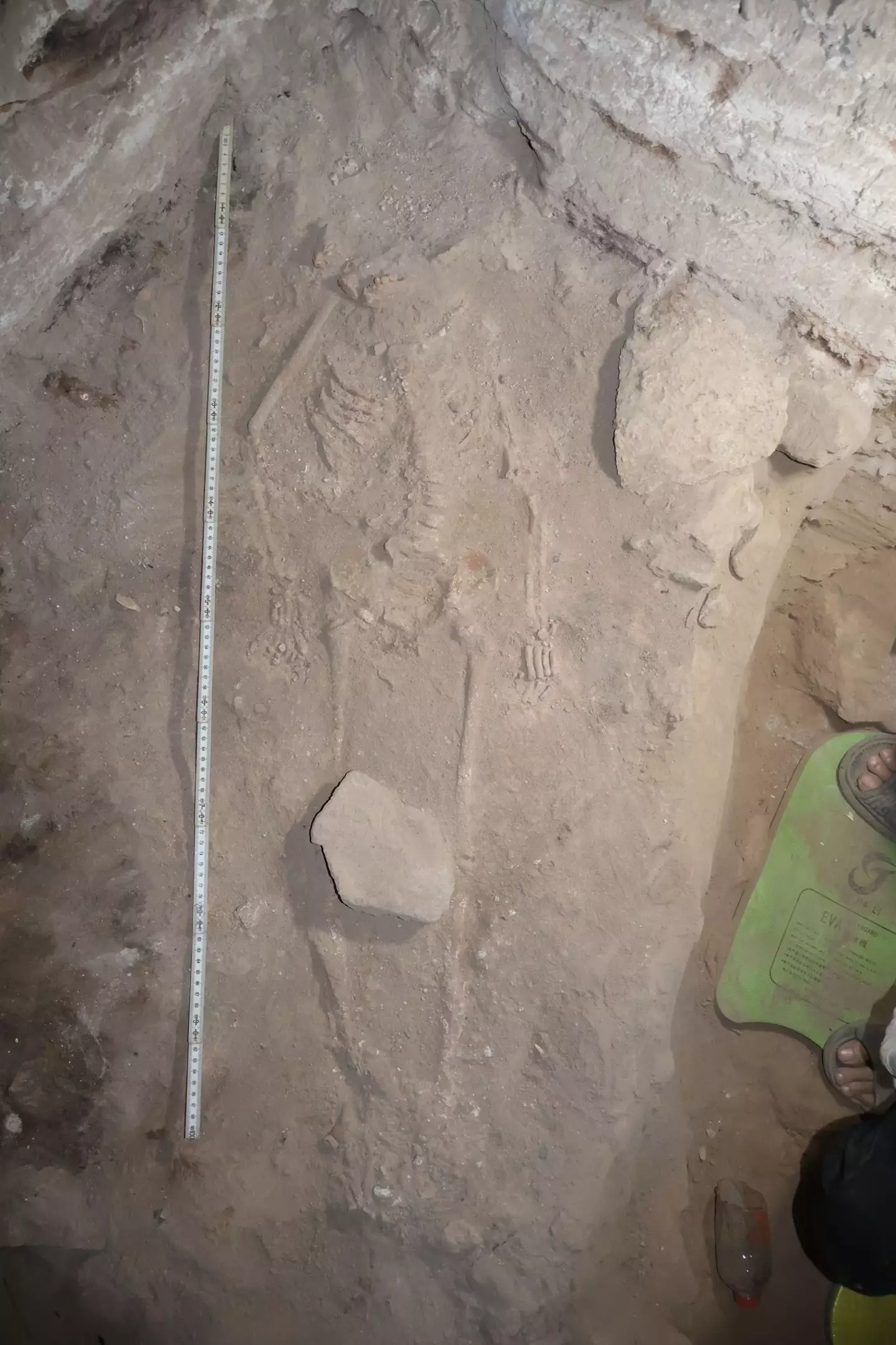

It’s a landmark discovery (นสพ.ประจวบโพสต์/Prachuap Post/Facebook)
Phnombootra Chandrajoti, the Director General of the Fine Arts Department said: “This is a groundbreaking discovery that will reshape our understanding of early human presence in Southeast Asia.
“The careful burial and the associated artefacts provide invaluable insights into the rituals and daily lives of these ancient inhabitants.”
Pangpond was also found to be in a specific position, stretched on their back with their arms and legs close to their body, which suggests they were respectfully put to rest after being wrapped or tied before burial.
Meanwhile, ash and charcoal around the grave suggest a fire was built around it – a deliberate practice of our prehistoric ancestors to deter wild animals.
The FAD commented: “The body was carefully placed and surrounded by stones, indicating a level of respect and care in the burial process.
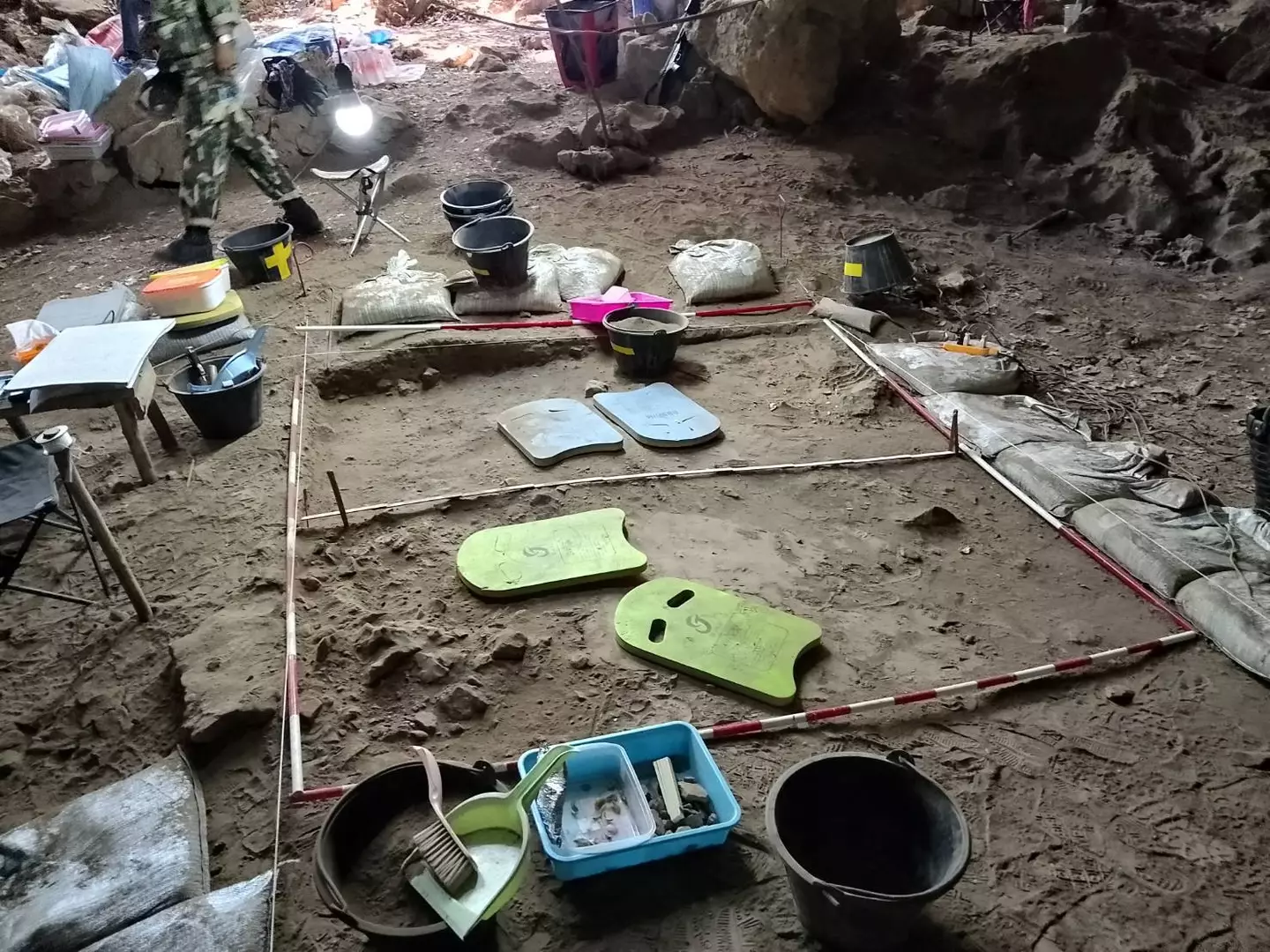

Archaeologists made the groundbreaking discovery last month (นสพ.ประจวบโพสต์/Prachuap Post/Facebook)
“The positioning of the limbs, with the toes touching, suggests the body may have been wrapped or tied before burial,” reports the Daily Star.
Through soil and fossil analysis, experts believe Pangpond’s remains could be older than 29,000 years and date back to a landmass now submerged under water, Sundaland, which used to connect swathes of land across Southeast Asia during the last ice age some 110,000 to 12,000 years ago.
The archaeological site first attracted interest in 1996 with the landmark discovery of prehistoric rock paintings, and in 2020, teams started studying the works made in red ocher on the walls and ceilings of three chambers in the cave.


The remains are believed to be 29,000 years old (Fine Arts Department/Facebook)
Many of the paintings appear to depict people as well as hunters with bows and arrows.
Further excavation of the site in 2022 uncovered animal bones, shells, seeds and stones that suggested early humans used the cave, while radiocarbon dating of the items indicated a prehistoric community lived there some 11,000 to 29,000 years ago.
A FAD spokesperson added: “The Din Cave site offers a unique window into the past, documenting the evolution of human societies over thousands of years.
“Further research and analysis will undoubtedly shed more light on the lives of these ancient people and their contributions to the region’s rich history.”
Featured Image Credit: Courtesy of Fine Arts Department
Topics: History, Science, Thailand, World News, Art
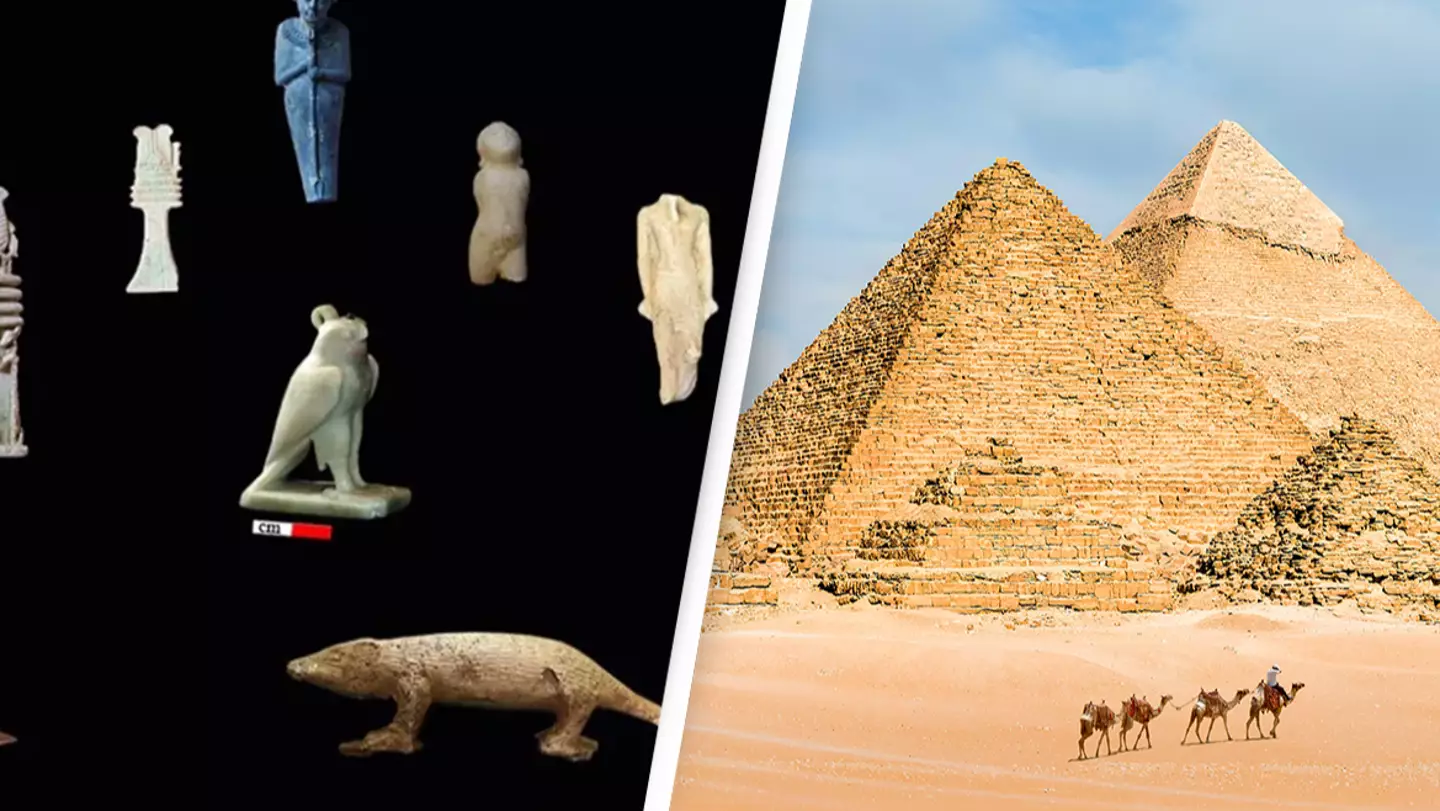

Archeologists believe they’ve found the first astronomical observatory on record.
The discovery was made during excavation efforts the ancient city of Buto, now called Tell Al-Faraeen, when the team came across an L-shaped mud-brick building.
Initially they thought that it was an ancient temple that they’d stumbled across as the building appeared to be a monumental gate of an Egyptian temple known as a pylon.
But as the excavation went on, the archeologists uncovered artefacts and inscribed symbols relating to time and astronomy.
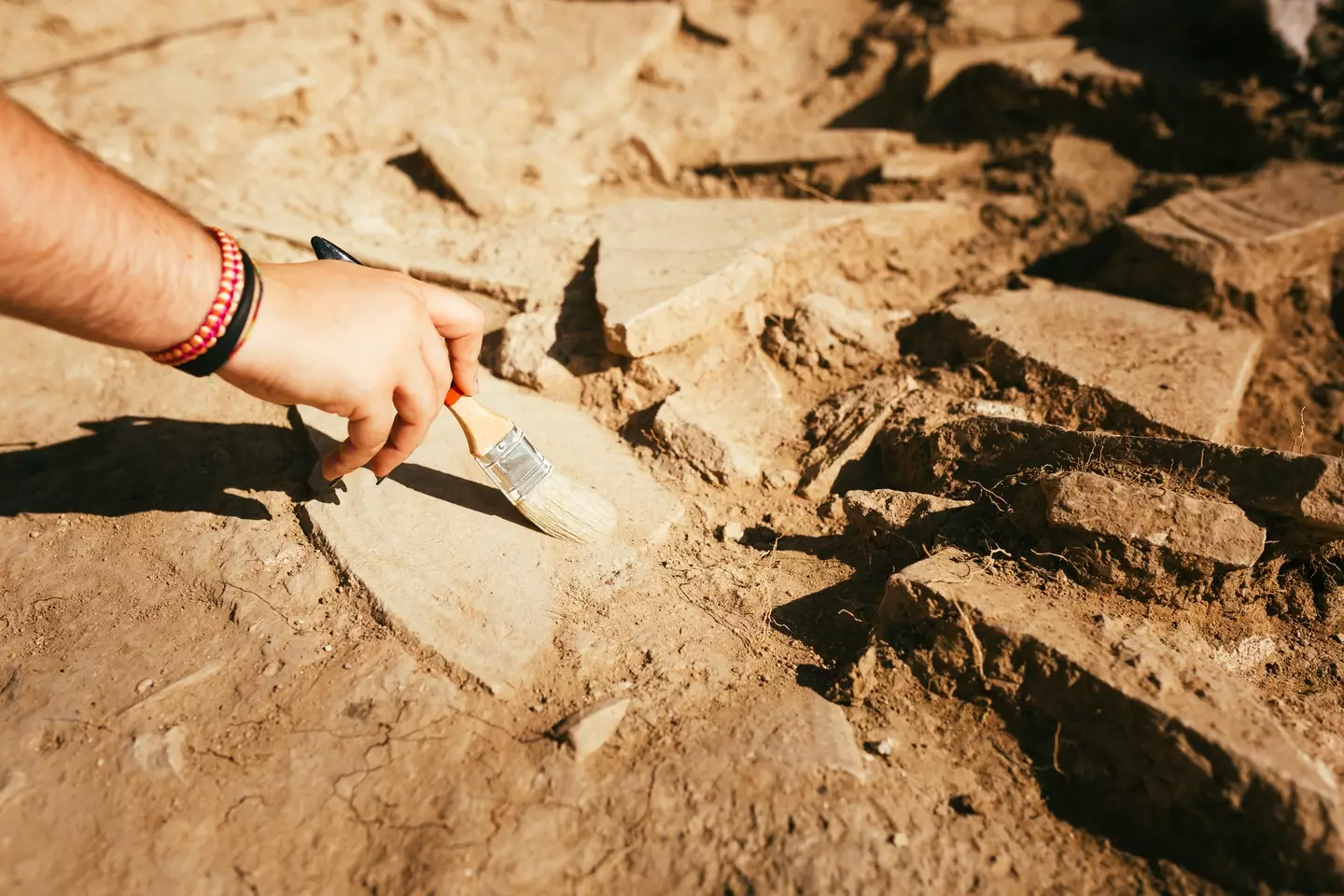

Archaeologists in Egypt discovered the first astronomical observatory on record (Getty Stock Image)
The team then came across a slope stone sundial – also known as a sloping shadow clock – that led researchers to make the new announcement that this structure was in fact a huge observatory that sprawls over a quarter of an acre (850 square meters).
Another thing that alerted them to the fact that the building was likely to be an observatory rather than a temple was ‘a triad of pillars’ which researchers think ‘represent the ancient Egyptians’ tripartite division of time into seasons, months and weeks’.
According to the country’s Ministry of Tourism and Antiquities, the observatory is ‘the first and largest astronomical observatory building’ on record and it would have been used to ‘observe and record astronomical observations and the movement of the sun and stars’.
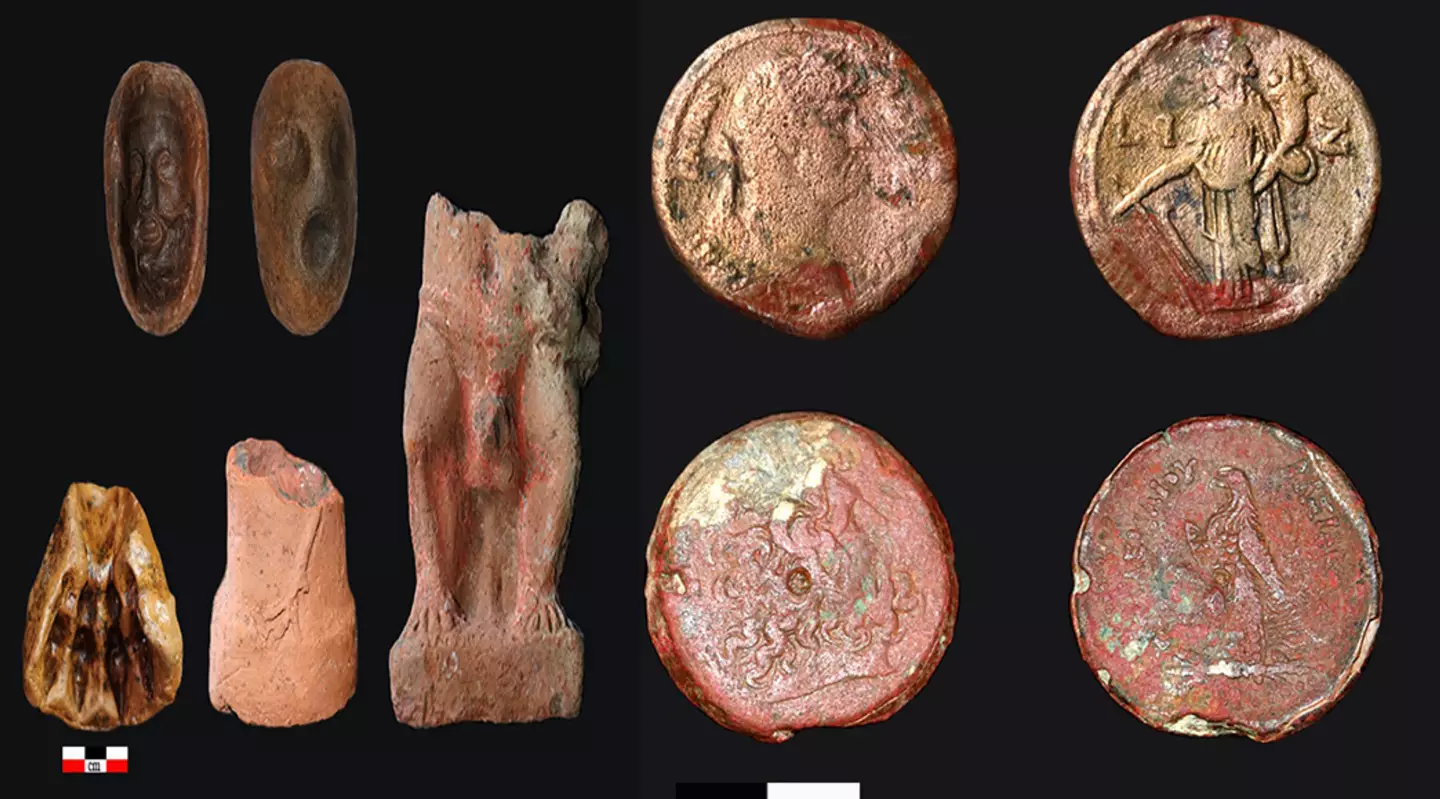

The artefacts date back thousands of years (The Egyptian Ministry of Tourism and Antiquities)
Elsewhere Dr. Mohamed Ismail Khaled, Secretary-General of the Supreme Council of Antiquities, said that the discovery ‘confirms the ingenuity and skill of the ancient Egyptians in astronomy since ancient times’.
Speaking about the historic find, Hossam Ghonim, director general of Kafr El-Sheikh Antiquities and head of the Egyptian archaeological mission, said to Live Science: “Everything we found shattered our expectations.”
He continued to say of the sundial they found: “Along the hall’s northern side, we discovered a slanted stone sundial – a sun shadow clock that used the shifting angles of the sun’s shadows to determine sunrise, noon and sunset – a simple yet profound method.”


The artefacts helped researchers confirm that it was an observatory (The Egyptian Ministry of Tourism and Antiquities)
Including the sundial, researchers found construction features that also suggested alignments with the sun, Space.com reports.
One example of this was three stone blocks on the ground which will have been used to ‘take measurements of the sun’s location’.
Dozens of artefacts also believed to be associated with an astronomical observatory were locating the large building such as a statue of the falcon-headed god Horus, a bronze figure of Osiris and a a beaded necklace known as a Menat.
It’s believed the observary was found three years ago, but Egypt’s Ministry of Tourism and Antiquities has only just announced the news in recent days.
Featured Image Credit: Ministry of Tourism and Antiquities/Getty/Nick Brundle Photography
Topics: History, News, Space, World News, Egypt
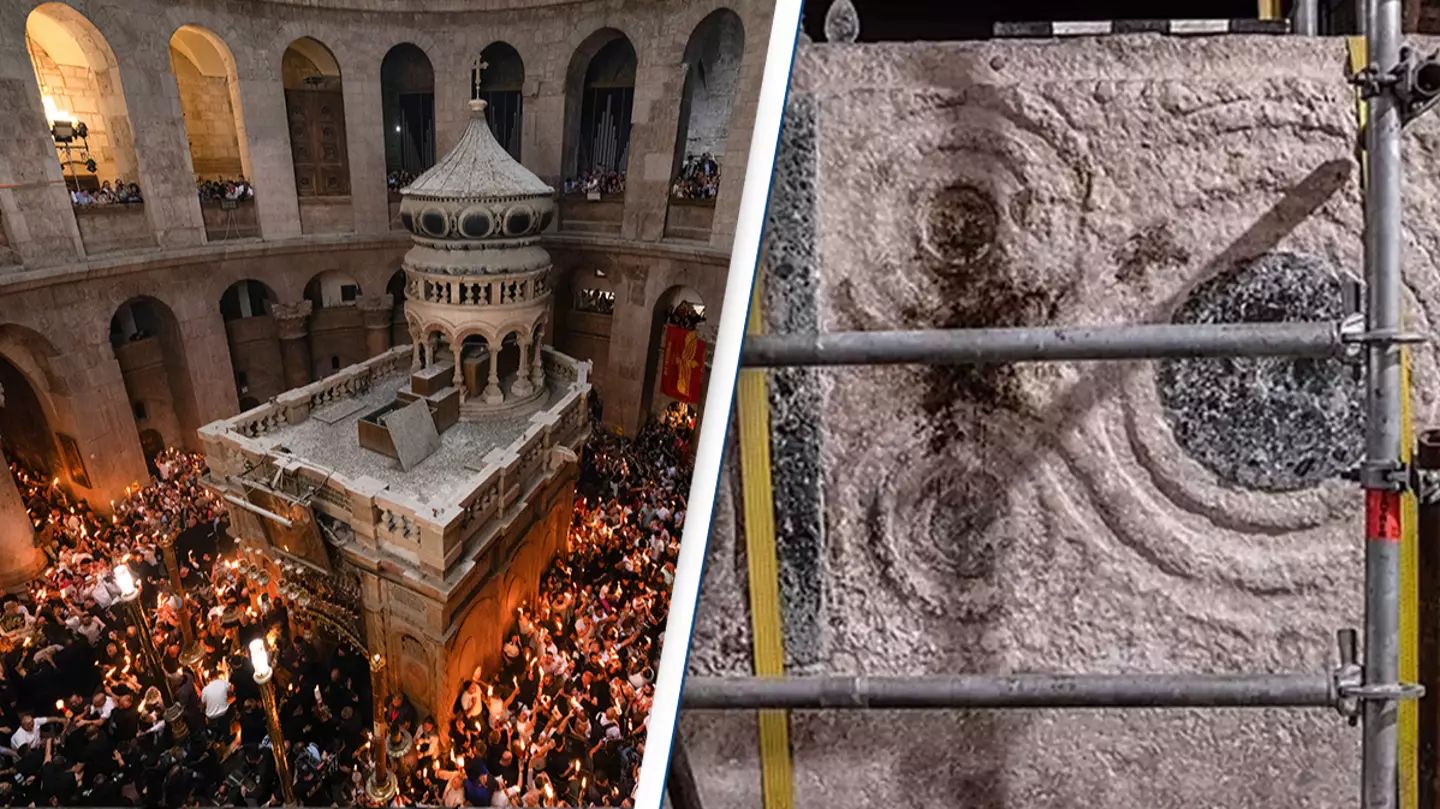

Austrian archaeologists have revealed details of an ‘sensational’ discovery made at one of the holiest sites in Christianity.
The Church of the Holy Sepulchre, also known as the Church of the Resurrection, is a fourth-century institution nestled within the Old City of Jerusalem.
The site is considered one of the holiest in the world as Christians believe the area is where Jesus was buried and later rose from the dead.
Experts have recently flocked to the church following the news that construction workers were awestruck upon turning over a chunk of seemingly worthless marble.


A graffiti-covered stone has caught the world’s attention. (Amit Re’em/Israel Antiquities Authority)
The stone, which had been sitting in a publicly accessible corridor near the rear of the building, measured eight feet long and five feet wide.
On the side facing the public, the marble was covered in graffiti.
However, when the stone was flipped around, revellers saw that the other side was decorated with ribbon ornaments and distinct markings.
Upon further inspection, it was declared that these unique decorations were made using a special production technique called ‘Cosmatesque’.
The art form was once practised by guild masters in papal Rome and saw large surfaces being covered with smaller quantities of precious marble.
Excitingly, archaeologists have since identified the slab as the front panel of the altar consecrated in 1149.
Historians previously believed the largest-known medieval altar, used by Crusaders in the Middle Ages, had been destroyed in a fire in 1808 and thus lost for decades.
“For historians, this find is a sensation in several respects,” wrote the Austrian Academy of Sciences (OeAW).
While remarking on the brilliance of the find, researchers also questioned how the important slab had ‘remained hidden for so long in such an intensively researched building as the Church of the Holy Sepulchre’.
Speaking about the significance of the altar Ilya Berkovich, historian at the Institute for Habsburg and Balkan Studies of the Austrian Academy of Sciences, said: “We know of pilgrim accounts from the 16th, 17th and 18th centuries about a magnificent marble altar in Jerusalem.
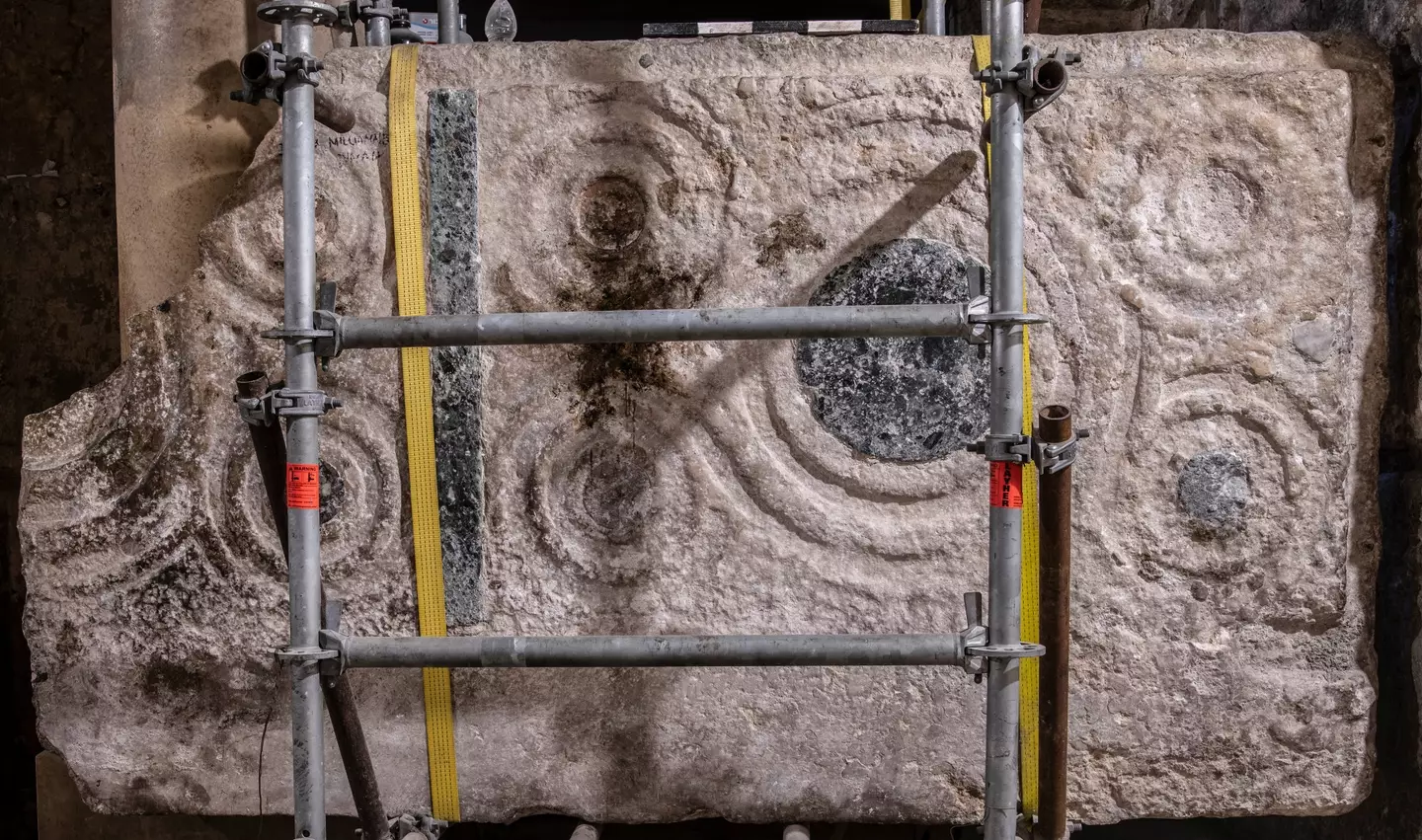

The altar was consecrated in 1149. (Shai Halevi/Israel Antiquities Authority)
“In 1808, there was a major fire in the Romanesque part of the Church of the Holy Sepulchre,” said Berkovich. “Since then, the Crusaders’ altar was lost – at least that’s what people thought for a long time.”
This discovery, hailed as ‘sensational’ by the OeAW, is thought to have been created with the Pope’s blessing.
Moreover, they write that it was commissioned to honor Christianity’s holiest church as Cosmatesque art was a cherished status symbol.
“The Pope thus paid tribute to the holiest church in Christianity,” Berkovich said.
Following the recent discovery of the altar, the expert and his team hope to research further and dive into the papal archives to reveal more details about the stone.
They also want to uncover the Cosmatesque master who created the artwork.
Featured Image Credit: Getty Images/FAIZ ABU RMELEH/Middle East Images/AFP/Shai Halevi/Israel Antiquities Authority
Topics: History, Science, Religion, World News


Someone 2,000 years ago might be feeling a little red-faced right now if they knew what scientists had stumbled upon.
Society changes quite a lot every couple of years and the world we live can be vastly different to that of the past.
But in a lot of ways, it can be very similar.
While many people may believe people of the past and ancient civilization may have been more ‘prudish’ or reserved when it came to sex or sexual exploration that isn’t strictly true.
A study published last year in February in the journal Antiquity had looked at a group of objects that were recovered in 1992, namely a penis-shaped piece of wood and question whether one of its uses had been overlooked.
“Stone and metal phalli are known from across the Roman world, but the Vindolanda example is the first wooden phallus to be recognized,” the study stated.
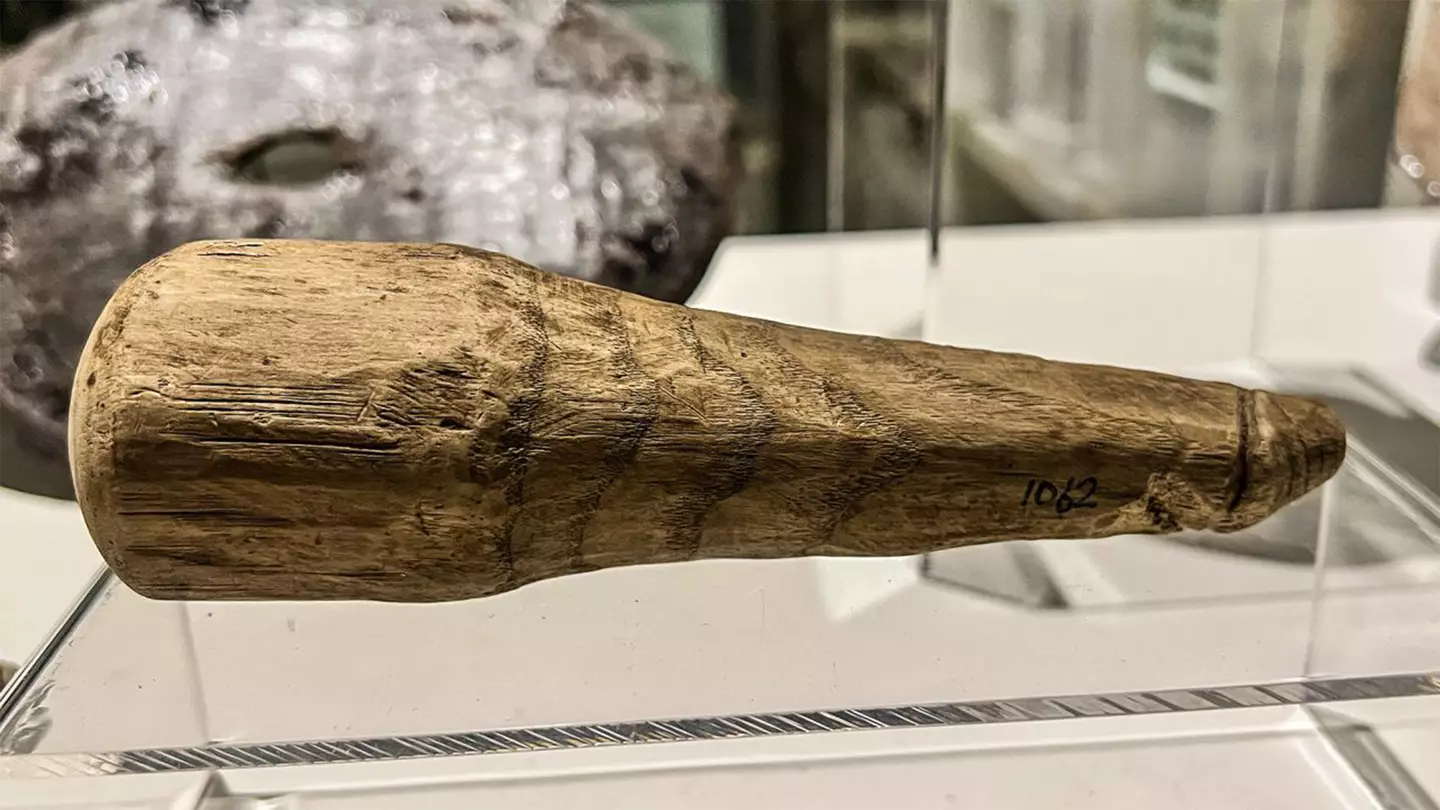

The object was was discovered in England. (The Vindolanda Trust)
Archaeologists initially found the almost seven-inch-long artifact in a ditch near Vindolanda which was the remains of a Roman Fort.
While it has been considered the object was used as a sewing tool, as it was found alongside shoes and small tools, there have also been a few other suggestions.
Some have argued it could have been used as a good luck charm to ward off ‘evil’.
People living within the Roman empire may have seen nothing out of the ordinary in using a dildo as a sex toy as well as a good luck charm. What an empire.
An analysis from Newcastle University and University College Dublin found that this is the first known example of a disembodied wooden phallus found in the Roman world.


The artifact is almost seven inches long. (R. Sands)
Rob Collins, a study co-author and archaeologist from Newcastle University, said that despite the possibilities of it being used as a sex toy, it can be difficult to be absolutely certain.
“The size of the phallus and the fact that it was carved from wood raises a number of questions to its use in antiquity,” he said.
“We cannot be certain of its intended use, in contrast to most other phallic objects that make symbolic use of that shape for a clear function, like a good luck charm.
“We know that the ancient Romans and Greeks used sexual implements – this object from Vindolanda could be an example of one.”
The object is currently on display at the Vindolanda at the museum in England.
